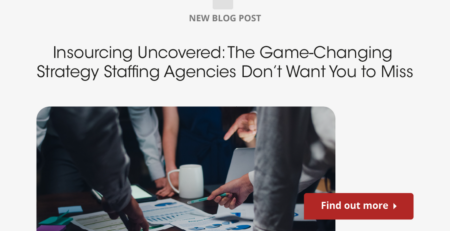Design Work for Corporations vs. Small Agencies: What’s the Difference?
You might already have some conception of a corporate work environment in your mind: grey concrete, endless cubicles, masses of people with briefcases and ties bustling back and forth in large atriums, and an opaque internal bureaucracy. Small agencies, on the other hand, are all colorful and filled with a handful of youthful disruptors with limitless ideas and energy.
Of course, neither of these depictions tells the whole story. Successful small agencies turn into corporations and big companies frequently mimic the small agency model to keep their talent happy.
So, what is it like working as a designer at a corporation and a small agency? Is one better than the other, or is it basically the same? Read on if you’re considering job options at either or curious to see what design work is like in a different environment.
What Is It Like Working as a Designer?
Broadly speaking, designers are brought on to either think of a way to present a product to users in a way that entices them to respond to a call to action, usually to buy a product or subscribe to a service. Companies’ business goals have to be translated to prospective customers and they hire designers to do just that.
Specific types of designers like graphic designers, UX/UI designers, and product designers complete this task in different ways. They may also form an art department or a small team that works together to build appealing designs.
Design work is typically overseen by managers, supervisors, or department heads. People in these positions who can influence the outcome of a project are called stakeholders. Designers often have to present prototypes and other concrete deliverables to stakeholders in an effort to demonstrate the design thinking behind a certain project.
The process from brainstorming to research to prototypes is done in iterations, or unique versions, that are changed to accommodate new information from users until the product does what the company needs it to do. Although this same general approach is used by both corporations and small agencies, working as a designer isn’t exactly the same in both environments.
Large-Scale Design Projects at Corporations
The main thing about design work at corporations is that you’re much more likely to share it with other designers. Some corporate design teams are small, made up of only a few people. In others, there might be over 20 designers.
One definite trend is higher design literacy across businesses. Fewer of the biggest companies still need to be convinced that design can help them reach their business goals because they’ve seen it in action. That also could mean designers at corporations are much busier with multiple projects.

Major corporations typically can’t survive if their people are completely in the weeds all the time, though. You might have more work as a designer at a big corporation but there will also be more resources to help you get through your projects and more money in the hiring budget to bring on some help when it’s needed.
Small-Scale Agency Projects
When we say small-scale, that’s only compared to the massive scale of corporate design projects. Agencies still frequently make designs that are seen by millions of people.
The limitations imposed on designers who work at a small agency are usually related to scarcity. Small teams and sometimes even talented individuals will handle entire projects by themselves and are much more likely to report directly to the CEO of the company.
Many designers who like working at a small agency prefer a smaller number of coworkers. It could be possible to meet and know everyone in the company by name and build long-term connections with them, which is a great way to keep talent happy.
Sometimes, though, individual designers have an urge to grow professionally and many small agencies aren’t interested in scaling up. It can be part of the appeal to people who like more personal workspaces and larger responsibility at the same time that it is a drawback for people who want their design work to reach millions and millions of people.
Design Thinking at Large Corporations
The biggest companies have been incorporating design into their business practices for decades and are more likely to have a set and structured explanation of the design theory used by the company. This can make onboarding really informative for designers but that onboarding process will also take more time to complete.
There’s certainly no unified design thinking across large businesses simply because of their size. So while it is nice that these larger companies might have a more step-by-step introduction to their design thinking, it’s also possible that you’ll have to reorient yourself to different ways of doing things if you ever take a job at a different company.
Design Thinking at Small Agencies
Smaller agencies, especially those that are happy with their size and not looking to scale up or grow very much, are more likely to have unique ways of looking at things. Designers might be onboarded very quickly and more or less taught about the company’s design thinking on the job.
However, you should also be aware that for many of these companies, these design projects are defining the company in real-time. For small boutique design firms, the design is the purpose of the business rather than a secondary necessity like it is at many corporations.
Because the design thinking of a small agency has such outsized importance, you’re also more likely to find yourself surrounded by people with some design sense, if not outright design skill. That’s great for people who have a passion for design and will discuss it at length, but you might also but heads with people more if they have their own idea about how they would build a certain design.
Advantages of Working as a Designer at a Corporation
Every big corporation is not the same and the market can create a necessity for new business practices at practically any time. However, here are some things you can more than likely look forward to if you work as a designer for a large corporation:
- Tons of Resources
It’s not only that these corporations usually have bigger budgets. They also have huge databases of past work and people who have worked on spectacularly specific projects. Unless you’re moving in unchartered design territory, there’s probably someone around who can walk you through what you’re working on.
- Massive Exposure
Designers who want their work to be seen by as many people as possible try to make it happen by working with huge companies. Since they already have some kind of product or service built-up, their audience is huge. You could be designing advertisements or products that are meant to be mass-produced and shown to millions of people around the world.
- Specialization
Larger teams mean more people are sharing the responsibility for projects, so individual designers can concentrate on building the types of skills that appeal to them the most. While smaller agencies might expect their designers to be generally skilled, corporations usually have point people for every step of a design project.
- Detailed Branding
The products that make big companies successful are held with a kind of reverence within the company. Huge teams of people have been establishing the brand for generally longer periods than what you’ll find at small agencies. That means designers who join the team already have conventions to play with, a history to draw on, and a much more nuanced product overall.
- More Likely Career Growth
There are many ways for people to be promoted in large companies. Since there is a larger hierarchy and more applications are being received, it’s common for people to move up over the course of their career with a given corporation. In addition to an increased likelihood, the large size of these companies means there are positions with them that simply don’t exist at smaller firms and agencies.
Cons of Corporations
Designers are going to be noticed much less frequently and have their name on their work much less at big corporations. You’re going to be a small fish in a very big pond, depending on the size of the company and how much importance it gives to its design teams.
Although it is nice to have a rich brand history to work within, you might also find it challenging to stay motivated when the projects are always so similar. Unless the brand resonates with you on a personal level, some amount of boredom is to be expected eventually.
Corporations may also have long-winded processes in place for their designers that are all but impossible to affect from your position as a designer. That means you might get stuck doing things in a way that doesn’t suit you. Worst of all, you might get used to doing things in a way that feels unnatural so that when you do leave you have to work to correct that behavior.
Advantages of Working as a Designer at Small Agencies
From boutique firms to more moderately-sized businesses, design work at a smaller agency is a great way for designers to put their skills to the test. Some of these advantages are less likely as you get to larger firms, but you can still expect them to some degree at smaller companies.
- More Creative Control
The smaller the organization, the more likely it is that you’ll have the final say in what your design looks like and how it’s implemented. We’ve already mentioned how the company itself will care more about the design than a corporation probably will, but that usually translates to greater personal investment in the designer.
- Transferable Skills
As a team player and a catch-all designer, you’ll be gaining a more comprehensive skill set that will translate more readily to other jobs if you design to change companies later on. Working as a designer at a small agency is also a great way to find out what aspects of design you enjoy the most, making it an ideal starting place for beginners fresh from school.
- Know Your Boss (Clients, Too!)
The smaller scale of things makes it more likely that you’ll have plenty of face-to-face time with management and with the clients. That means you’ll be taking more direct personal responsibility for your design by the people who commission it. You can also express concerns more clearly and all the employees will have a louder voice within the company.
- Outside-the-Box Thinking
Small agencies are more flexible and more willing to try out new things when it’s justified. Designers who want to experiment and take their design thinking to a new level are more likely to find a venue for that expression at a small agency than they are at a huge corporation that has years of branding and products to consider with every design decision.
- Less Office Politics
At huge corporations, decisions are often being made by teams and individuals that you never see. Sometimes people are just following orders but not sure where they came from, which can generate disagreements that are essentially unsolvable. Smaller agencies make it much easier to resolve such disputes and misunderstandings because the people who work there are more likely to know each other and know who to go to to solve problems.
Cons of Small Agencies
At a small agency, you’re probably going to have way more deadlines and far less consistency between projects. That’s great for building a diverse skill set, but it can also make you feel on the move constantly. Designers at small agencies might not be able to take as much vacation time if they have lots of responsibility so the long-term fatigue can be quite high at small- and mid-sized companies.
You’re also going to get some annoying clients from time to time since you’ll have so many more at a small agency than you will at a corporation, where the client is more or less always the same. The strategy for working as a designer effectively at a small agency is to work fast on your projects and don’t let occasional bad apples ruin your mood.
The increased responsibility is enough to drive some people away from smaller agencies where they have to answer for entire projects rather than a singular aspect of a design project like they would at a corporation. That being said, some designers discover that they love the additional control when they move from huge companies to smaller agencies.
Corporations vs. Small Agencies: Where Do Designers Make the Most?
All of the creative and workplace benefits we just mentioned are enough to make some people make their decision. But, naturally, the salary must be taken into account when considering any job.
At first thought, it might seem obvious that huge companies would pay higher salaries because they have more money. But that’s not always the case because the overhead at a huge company is also staggeringly high. For all the profits reaped by the design work produced at big businesses, some must be used to pay for the larger team, more tech, licensing, and saved to use for future growth.
Small agencies frequently aren’t interested in growth at all. Since they’re sustaining and don’t have nearly the overhead you would find at a big company, smaller agencies might also have a higher budget for paying their designers, especially when the design is making such an outsized impact on the final product.
For other things like health benefits, corporations might offer a better deal because there are way more people in the insurance pool. Then again, since the owner of the small agency knows all the employees and may even be close with them, there may be more care taken in choosing a health plan that everybody likes.

Conclusion
In the dynamic world of design, acknowledging and embracing the diverse needs of corporations and small agencies is key. By incorporating insights from the iCreatives blog, designers can stay informed about the latest trends and strategies, enhancing their ability to navigate the intricate challenges posed by these distinct design environments.
Making a choice between working at a large corporation and a small agency isn’t easy. On the one hand, you can have more stability and work with an extensively established brand at a big company, but on the other hand, small agencies give you more room for personal responsibility for your work and additional freedom to take risks.
In the end, it will depend on the personality of the specific designer. Some are built to shine in small firms while others are better off specializing on a design team at a corporation. You might even try both throughout your career. Regardless of what size company you work for, it’s important to keep things fresh so you can stay creative.












